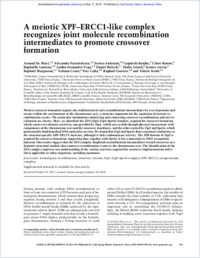A meiotic XPF-ERCC1-like complex recognizes joint molecule recombination intermediates to promote crossover formation
- De Muyt, Arnaud UMR3244, Centre Nationnal de la Recherche Scientifique (CNRS), Institut Curie, PSL (Paris Sciences and Letters) Research University, 75005 Paris, France - Université Pierre et Marie Curie (UPMC), 75005 Paris, France
- Pyatnitskaya, Alexandra UMR3244, Centre Nationnal de la Recherche Scientifique (CNRS), Institut Curie, PSL (Paris Sciences and Letters) Research University, 75005 Paris, France - Université Pierre et Marie Curie (UPMC), 75005 Paris, France
- Andréani, Jessica Institut de Biologie Intégrative de la Cellule (I2BC), Institut de biologie et de technologies de Saclay (iBiTec-S), Commissariat à l’Énergie Atomique et aux Énergies Alternatives (CEA), UMR9198, CNRS, Université Paris-Sud, 91190 Gif-sur-Yvette, France - Université Paris Sud, 91400 Orsay, France
- Ranjha, Lepakshi Institute for Research in Biomedicine (IRB), Faculty of Biomedical Sciences, Università della Svizzera italiana, Switzerland Claire Ramus,6
- Laureau, Raphaëlle UMR3244, Centre Nationnal de la Recherche Scientifique (CNRS), Institut Curie, PSL (Paris Sciences and Letters) Research University, 75005 Paris, France - Université Pierre et Marie Curie (UPMC), 75005 Paris, France
- Fernandez-Vega, Ambra UMR3244, Centre Nationnal de la Recherche Scientifique (CNRS), Institut Curie, PSL (Paris Sciences and Letters) Research University, 75005 Paris, France - Université Pierre et Marie Curie (UPMC), 75005 Paris, France
- Holoch, Daniel Université Pierre et Marie Curie (UPMC), 75005 Paris, France - 7Institut Curie, PSL Research University, UMR934, CNRS, 75005 Paris, France
- Girard, Elodie Institut Curie, PSL Research University, Mines ParisTech, U900, INSERM, 75005 Paris, France
- Govin, Jérome University of Grenoble Alpes, CEA, Institut National de la Santé et de la Recherche Médicale (INSERM), Institut de Biosciences et Biotechnologies de Grenoble (BIG-BGE), 38000 Grenoble, France
- Margueron, Raphaël Université Pierre et Marie Curie (UPMC), 75005 Paris, France - 7Institut Curie, PSL Research University, UMR934, CNRS, 75005 Paris, France
- Couté, Yohann University of Grenoble Alpes, CEA, Institut National de la Santé et de la Recherche Médicale (INSERM), Institut de Biosciences et Biotechnologies de Grenoble (BIG-BGE), 38000 Grenoble, France
- Cejka, Petr Institute for Research in Biomedicine (IRB), Faculty of Biomedical Sciences, Università della Svizzera italiana, Switzerland - Department of Biology, Institute of Biochemistry, Eidgenössische Technische Hochschule (ETH) Zurich, 8093 Zurich, Switzerland
- Guérois, Raphaël Institut de Biologie Intégrative de la Cellule (I2BC), Institut de biologie et de technologies de Saclay (iBiTec-S), Commissariat à l’Énergie Atomique et aux Énergies Alternatives (CEA), UMR9198, CNRS, Université Paris-Sud, 91190 Gif-sur-Yvette, France - Université Paris Sud, 91400 Orsay, France
- Borde, Valérie UMR3244, Centre Nationnal de la Recherche Scientifique (CNRS), Institut Curie, PSL (Paris Sciences and Letters) Research University, 75005 Paris, France - Université Pierre et Marie Curie (UPMC), 75005 Paris, France
-
24.01.2018
Published in:
- Genes and development. - 2018, vol. 32, no. 3-4, p. 283-296
English
Meiotic crossover formation requires the stabilization of early recombination intermediates by a set of proteins and occurs within the environment of the chromosome axis, a structure important for the regulation of meiotic recombination events. The molecular mechanisms underlying and connecting crossover recombination and axis localization are elusive. Here, we identified the ZZS (Zip2–Zip4–Spo16) complex, required for crossover formation, which carries two distinct activities: one provided by Zip4, which acts as hub through physical interactions with components of the chromosome axis and the crossover machinery, and the other carried by Zip2 and Spo16, which preferentially bind branched DNA molecules in vitro. We found that Zip2 and Spo16 share structural similarities to the structure-specific XPF–ERCC1 nuclease, although it lacks endonuclease activity. The XPF domain of Zip2 is required for crossover formation, suggesting that, together with Spo16, it has a noncatalytic DNA recognition function. Our results suggest that the ZZS complex shepherds recombination intermediates toward crossovers as a dynamic structural module that connects recombination events to the chromosome axis. The identification of the ZZS complex improves our understanding of the various activities required for crossover implementation and is likely applicable to other organisms, including mammals.
- Language
-
- English
- Classification
- Medicine
- License
- Open access status
- hybrid
- Identifiers
-
- RERO DOC 324198
- DOI 10.1101/gad.308510.117
- ARK ark:/12658/srd1318913
- Persistent URL
- https://n2t.net/ark:/12658/srd1318913
Statistics
Document views: 136
File downloads:
- Texte intégral: 245
